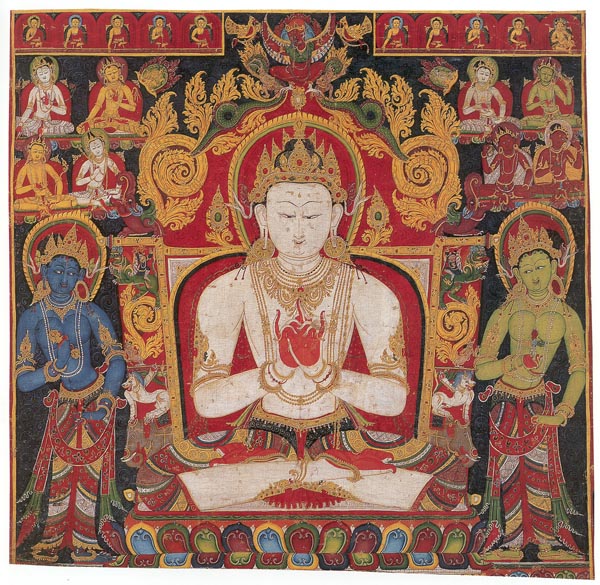| 41. Vairochana with Attendants
|

41.
Vairochana with Attendants
A Nepalese artist
Tibet, first half of the 14th century
Distemper on cloth
59.4 x 61 cm (233/8 x 24 in.)
Private collection.
|
This thanka, whose lower register is missing, is one of a small group of surviving early-fourteenth-century paintings in the Nepalese style. Vairochana, the Buddha of the Zenith, can be identified by his white coloration and
his gesture of bodhyagri mudra (wisdom fist). He is flanked by two female attendants.
Most probably they are:
to the right, a Green Tara holding a vajra and to the left, a blue Vajradhateshvara who also holds a
vajra.1 They stand in a frontal swaying posture, seemingly a variant ofthe ubiquitous
tribhanga (thrice-bent) pose, previously
used for standing bodhisattvas. Vairochana sits against a throne back that is very close in style to those seen in the
early Nepalese-inspired Tathagata set (cat. no. 36); it has the same bar at the base of the lotus seat, an identical
assemblage of animals to support the projecting bar at the top, and a torana that is similarly configured, but with the addition of two birds flanking the
Garuda. Eight bodhisattvas seated in the half-lotus posture (also similar to those seen in the Tathagata series, cat. no. 36) make up
a chorus of listeners. Some hold attributes, but it is not clear whether they are meant to be the auspicious Eight
Bodhisattvas (see cat. no. 28). Small flaming aureoles at the left and the right of the inner top bodhisattvas surround
dancing dakinis. Above, following the composition of the earlier series, is a short register with five deities in either
corner (rather than the four seen in the earlier group): to the right, Ratnasambhava, Avalokiteshvara,
Vairochana, Amoghasiddhi, and another deity; to the left, the five Tathagatas,
Amoghasiddhi, Ratnasambhava, Avalokiteshvara, Vairochana, and
Amitabha. The adornments worn by the principal deities reflect those seen in the earlier set. Note the parallel jewelry
(which is also akin to that seen in the Shalu murals), including the large anklets, although here the armlets are seen in profile rather
than head on. Here, Vairochana's dhoti is also worn over the knees, but the bodhisattvas' long trousers are made of
striped rather than diaphanous fabric.
A number of variations from the usual configuration of elements clarify this thanka's date as the first half of the
fourteenth century. The painting seems to be based on the early Tathagata set. The throne back is obviously similar,
although it has become less plastic; the bucket shape of the back has lost almost all its curvature. The only area in
which some of the earlier concavity is still evident is at the intersection of the uprights and the back, where the back
bar bends slightly. The projecting ends are also nearly parallel to the throne top rather than angled. The straight
sides and the top of the throne are now almost totally visible since they are no longer covered by a large pillow.
Also altered are the two lotus adornments that, in the early set, project upward from the throne back like spikes but
are completely lacking in the murals. Here, they emerge from the junction of the nimbus and throne back and
mirror the floral arms that surround the central boss of the crown. The flanking bodhisattvas (now female) are posed
frontally, rather than in a half-profile, half three-quarter view. Although the configuration of the foliage in the
torana corresponds quite closely to that seen in the early Tathagata set, it no longer exhibits the same bursting
energy, having become somewhat languorous and decorative. Finally, the background of the painting is filled
with scrolling rather than scattered falling bouquets.
Curiously, at the top center of the verso of the painting, "Vairochana" is written in early medieval Nepalese script, and in the Buddhist creed below it, penned in Tibetan letters, "dharma" is spelled with a double m, as it is in Nepali. This may be a further indication that the painting is the work of a Nepalese artist.2 SMK
1. Hazra 1986, p. 57. [back]
2. This hypothesis was proposed by Ian
Alsop. [back]
|
